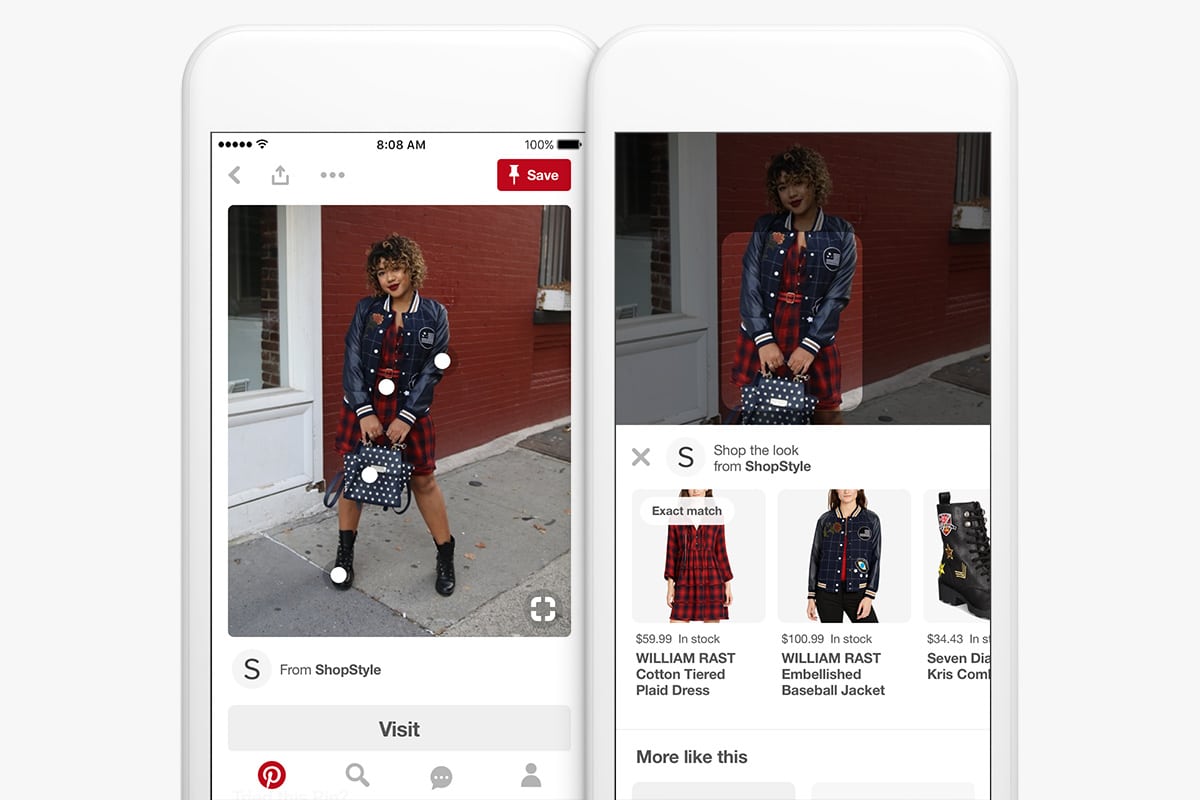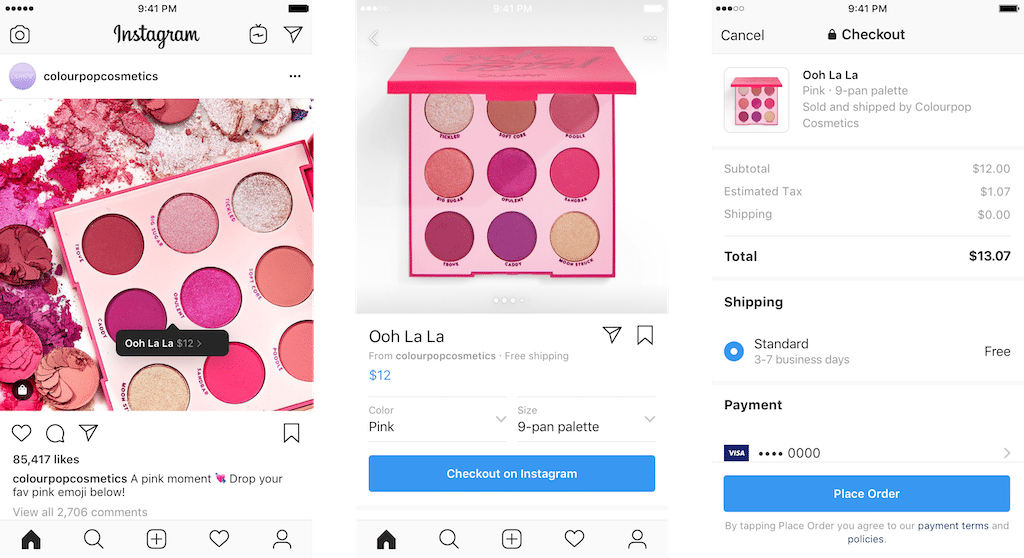Instagram or Pinterest? | A key outline of the visual platforms’ shopping functions
21/07/20
6'
At first glance, the social media platforms Instagram and Pinterest appear quite similar, made up of primarily images and visual content. However, the differences are crucial. Today, we take a look at which social commerce opportunities exist on each of these image networks for retailers and brands and which features are worthwhile in a time where it is particularly important to diversify your online sales channels.
The differences
One of the most important differences between the two platforms is the positioning. While Instagram continues to focus on social interaction and personal presentation, Pinterest is mainly used for inspiration and content and as a guide. Pinterest users search for recipes, decoration ideas, fashion trends, etc., yet rarely upload images and content themselves. While Instagram posts are displayed chronologically with an algorithm taking into account the user’s interests, Pinterest is sorted systematically by topic; major themes are gifts, do it yourself (DIY), decoration, garden, fashion or recipes.
The two image networks also differ in terms of usage and target group. With Instagram dominates users under 35 years of age by far; 70.6% of users are 34 or younger. The split between men and women is relatively balanced. Pinterest, on the other hand, has an older audience, with 27% of users over 45 years of age (but young people still dominate here as well). In Instagram, only 13.5% are in this age group. Furthermore, women make up 70% of Pinterest users.
This results in a different use for marketing. Instagram is particularly suitable when presenting one’s brand/company to a younger audience, while Pinterest offers the opportunity to present one’s own products in an inspiring way – to rather wealthy, engaged female buyers. On Pinterest, you can easily link to your online shop, generating direct traffic, which is a bit more difficult with Instagram.
A marketing strategy on both channels is a good idea if you wish to address a range of target groups. Read on for a breakdown of all the shopping functions on the platforms that are relevant for retailers and brands.
Pinterest: A marketplace for inspiration and content
Pinterest has more than 367 million active users worldwide (Q1 2020), the numbers are rising rapidly. In the UK a good 10 million people use Pinterest. When you consider that more than 90% of weekly users use the image network to plan a purchase, and more than half of all users search explicitly for products, one thing becomes clear: the potential for Pinterest in e-commerce is huge.
The visual search engine has therefore recently entered into several partnerships in e-commerce, whether with shop solutions such as Shopify or with feed managers such as Lengow. To date, Pinterest Shopping has seen catalogue feed uploads increase 144% sequentially in Q1 of 2020.
Amy VenerPinterest is a visual discovery engine and our users have a very different way of thinking than in social networks (…) they come to prepare a personal project and to be inspired in their daily life (…) they are actively considering what to buy next.
Head of Retail Strategy & Marketing Pinterest
1/ Product Pins and catalogues
Product Pins, unlike normal Pins, are enriched with certain data and formatted to show users that they can be bought. They contain information including price, availability, product title and description. If a user wants to purchase the corresponding product, they are directly forwarded to the respective online shop.
Retailers should use Pinterest’s catalogue tool for their products, so that product feeds can be better integrated. Product Pins from catalogues can also be added to product groups, which allow you to advertise them as Shopping Ads (normal Pins do not). Using a feed manager like Lengow for accurate and optimised product data is recommended (+ creation of rules/filters).
2/ Shopping Ads
Once product groups have been set up in catalogues, retailers can advertise them via Shopping Ads to bring products closer to users. Since Pinterest takes the product data from the data source to show interested users relevant products, no further targeting of Shopping Ads needs to be set up. If someone wants to buy an advertised product, one click takes them to your website or shop. 83% of “Pinners” have made a purchase based on content they saw from brands on Pinterest.
3/ Collections (Shop the Look)

Collections, also called Shop the Look Pins, are pins in which several products are marked in one image. For example, they represent complete outfits and have a link to each garment in the pin. This variant is only available for brands and retailers in the fashion, interior design and home furnishings sectors. A complete look brings inspirations to life even better. Each part of the look can then be clicked and purchased separately..
Sell with Pinterest Ads and Shopping
Improve your visibility and your sales with Pinterest and Lengow Throu…
Learn moreInstagram: the “new teleshopping”?
Over 1 billion people use Instagram worldwide, in Germany more than 21 million users are active. 90% of all users follow at least one company on Instagram. 72 % of them have already bought a product they have seen on Instagram. So there is sales potential here too. Companies and retailers have recognized the potential, accounting for 25 million active business accounts on Instagram.
Dan SeifertInstagram is to Millennials today what the QVC teleshopping channel was to previous generations
Editor for the US tech blog The Verge
1/ Instagram Shopping
Brands and retailers with a company profile can create Shopping Ads with clickable products in the image; the only requirement is a Facebook account. 130 million people interact with Instagram Shopping Ads every month. Users are forwarded to the respective online shop to complete the purchase, as with Pinterest. In a survey by GlobalData, 39% online shoppers aged 16-24 in the UK have used Instagram Shopping to buy a product.
2/ Instagram Checkout
Selected brands and retailers in the US have had access to Instagram Checkout since March 2019. This is a feature that allows users to shop directly within the Instagram app. The in-app checkout allows users to complete the entire customer journey and pay without leaving the platform. This checkout function avoids unnecessary frictional losses and drives up the conversion rate; Instagram stores payment data and only passes on the necessary transaction data such as delivery address and contact details to merchants.

More than a hundred brands already use the checkout function in the US, including Nike, Adidas, Zara, Revolve, Hollister, Steve Madden, Warby Parker, etc. Top influencers including the likes of Kim Kardashian West have already implemented checkout buttons on their pages.
Sell with Instagram Ads and Shopping
Optimise your Instagram ad campaigns with Lengow With this guide, find…
Learn moreMain image: Pexels
Images: Pinterest, Instagram
Your e-commerce library
Sign up for our newsletter
By submitting this form you authorize Lengow to process your data for the purpose of sending you Lengow newsletters . You have the right to access, rectify and delete this data, to oppose its processing, to limit its use, to render it portable and to define the guidelines relating to its fate in the event of death. You can exercise these rights at any time by writing to dpo@lengow.com

Trending Posts
Marketing channels
ChatGPT Ads and advertising on GenAI Search Engines: what you need to know
Advertising on generative AI-based search engines (GenAI) marks a new era in digital marketing. After two decades dominated by traditional…
22/05/25
6'
Marketing channels
Reddit and Social Commerce: When Users Take Back Control
Before buying anything, we compare. We hesitate. And more and more often, we end up typing the product name followed…
30/06/25
8'
Marketing channels
How to Sell on TikTok in 2025: The Ultimate Guide to Success
To sell or not to sell on TikTok? That remains a question many brands ask themselves. But here’s what you…
03/02/25
7'
E-commerce Trends
E-Commerce 2025: The New Rules of Digital Retail
What’s going on in e-commerce? A lot. If 2024 was the year brands got comfortable with marketplaces, AI tools, and…
11/07/25
8'
Marketing channels
Omnichannel Strategy: The Best Examples of Successful Brands
Consumers interact with brands through multiple channels, including online, in-store, and mobile apps. More than 90% of consumers expect a…
04/04/25
5'




